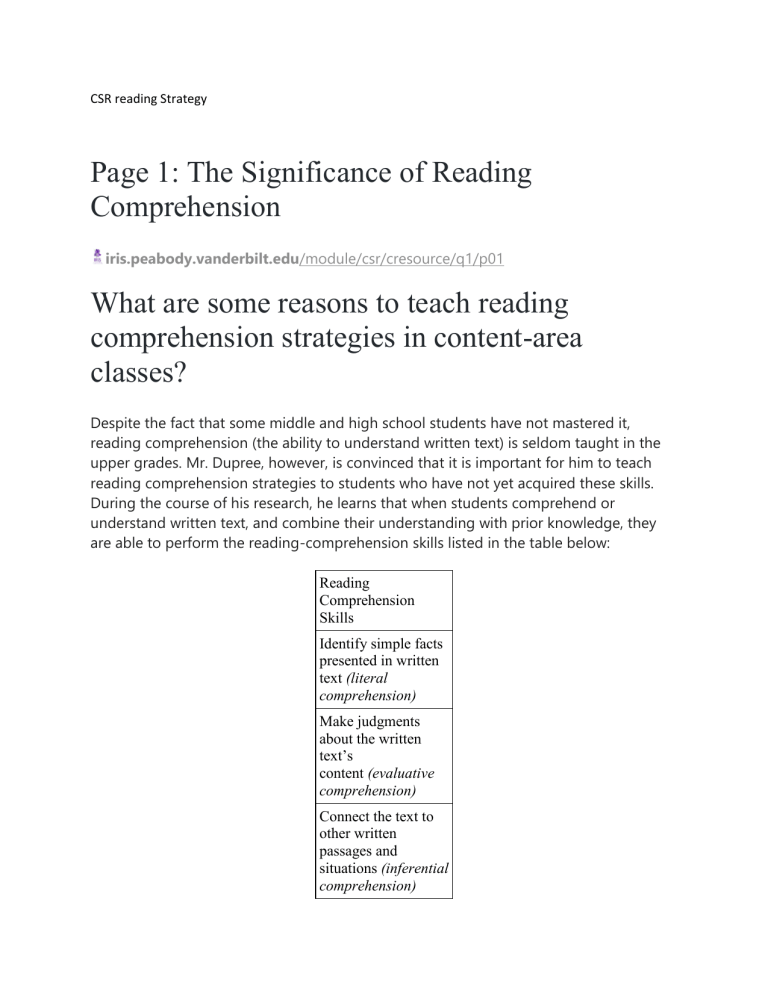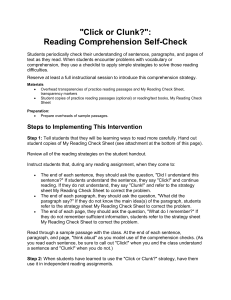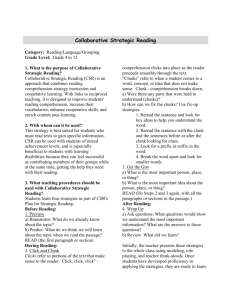
CSR reading Strategy Page 1: The Significance of Reading Comprehension iris.peabody.vanderbilt.edu/module/csr/cresource/q1/p01 What are some reasons to teach reading comprehension strategies in content-area classes? Despite the fact that some middle and high school students have not mastered it, reading comprehension (the ability to understand written text) is seldom taught in the upper grades. Mr. Dupree, however, is convinced that it is important for him to teach reading comprehension strategies to students who have not yet acquired these skills. During the course of his research, he learns that when students comprehend or understand written text, and combine their understanding with prior knowledge, they are able to perform the reading-comprehension skills listed in the table below: Reading Comprehension Skills Identify simple facts presented in written text (literal comprehension) Make judgments about the written text’s content (evaluative comprehension) Connect the text to other written passages and situations (inferential comprehension) Mr. Dupree recognizes that these three reading-comprehension skills are necessary if students are to benefit from the science textbook and, ultimately, to succeed in his class. Why Teach It? Mr. Dupree further learns that reading comprehension is critical to the development of all students’ reading skills. This is particularly true in the upper grades, where the curriculum requires that students comprehend increasingly complex expository text. Consequently, teachers expect that, once students complete the third grade, they will be able to read and understand textbooks in all subjects, including science. Keep in Mind Although it’s important to ask students questions about what they read, doing so is not the same as teaching them how to comprehend what they have read. Unfortunately, many middle and high school students haven’t learned effective strategies for comprehending expository text and for navigating this type of information. In addition, a lack of sufficient background knowledge and content-specific vocabulary also impede students’ ability to comprehend the subject matter. For Your Information Although reading comprehension is complex, students’ comprehension of texts may be influenced by several major factors: The reader — This includes the reader’s cognitive capabilities, motivation, knowledge, and experiences. The text — This includes the wording of the text and the way that the information is selected, described, or presented. The instructional activity — This includes the purpose of the activity, the nature of the activity itself, the operations performed to process the text, and the outcomes of the activity. The environment or context — This includes the classroom environment, especially the native language, culture, and ethnicity of the reader, the teacher, and the other students. Page 2: Improving Reading Comprehension iris.peabody.vanderbilt.edu/module/csr/cresource/q1/p02 What are some reasons to teach reading comprehension strategies in content-area classes? Having decided to teach reading comprehension strategies to his science students, Mr. Dupree embarks on a journey to learn more. As he had suspected, good readers automatically use comprehension strategies, but poor readers do not. He learns, however, that these comprehension strategies can be taught to poor readers. To do so, Mr. Dupree will make use of the four elements described below. Prior knowledge: Students are taught to think about what they already know about a particular topic. Next, students are asked to try to make a connection between their prior knowledge and the text they are reading. Vocabulary development: Students are taught to use diagrams or graphic organizers to help them to learn and remember the meanings of new words. Questioning techniques: Students are taught to generate questions before, during, and after reading. Students are asked to predict what they are going to read, to ask themselves during reading whether what they have read makes sense, and to generate questions about the text after reading. Opportunities to practice new skills: Students are given ample time in the day for independent reading and are encouraged to share what they have read. Good readers, like Sylvia, use various strategies to help them to organize, evaluate, and remember the information they encounter in expository texts. More specifically, before, during, or after reading, they may: Clarify their purpose for reading Make a plan for how to read the text Connect information to their prior knowledge Ask questions about the text Monitor their comprehension By contrast, poor readers, like Renee, lack knowledge of such strategies. They tend to comprehend little because they do not know how to make sense of the information they encounter in expository texts. Often, poor readers: Focus on decoding words Do not see connections among parts of the text Do not realize that they do not understand what they have read Do not understand the concept of reading for meaning Page 3: Introduction to CSR iris.peabody.vanderbilt.edu/module/csr/cresource/q2/p03 What can teachers do to improve their students’ reading comprehension? While conducting his research, Mr. Dupree discovers that Collaborative Strategic Reading (CSR) incorporates the four elements described on the previous page: Prior knowledge Vocabulary development Questioning techniques Opportunities to practice CSR is a multi-component reading approach developed to help students improve their reading comprehension. Its overall goal is to improve reading comprehension in a way that maximizes student engagement. Mr. Dupree learns that students with varying reading levels can use CSR to apply comprehension strategies while reading expository text in small cooperative learning groups. For Your Information Originally developed to improve the reading comprehension of students with learning disabilities, CSR has been shown to be equally effective with average- and highachieving students, struggling readers, and English learners (ELs). For this reason, CSR is an ideal Tier 1 strategy to use in classrooms that are implementing the response to intervention (RTI) approach. Considerations for Using CSR CSR was designed for use with the type of expository text found in subject area textbooks (although some teachers have adapted it to be used with narrative text). Despite the fact that teachers may not be able to select the textbook, it is easier initially to implement CSR if the selected passage: Is high-interest Consists of several paragraphs Contains one main idea per paragraph Is written at an appropriate reading level Contains clues to help students predict what they will be learning (e.g., highlighted vocabulary terms, headings, illustrations) Page 4: Overview of the CSR Reading Strategies iris.peabody.vanderbilt.edu/module/csr/cresource/q2/p04 What can teachers do to improve their students’ reading comprehension? CSR consists of four reading strategies that students apply before, during, and after reading a passage in a peer-mediated learning environment. Research has shown that these strategies—the Preview strategy, the Click and Clunk strategy, the Get the Gist strategy, and the Wrap Up strategy—are effective methods for improving reading comprehension. The table below includes a brief description of each. Strategy Description Before Preview Students activate prior knowledge and make predictions about what they will Reading learn from the text. During Click and Students monitor their comprehension of vocabulary as they read, applying fixReading Clunk up strategies to infer the meaning of unknown words by their context. Get the Gist Students identify the most important information contained within each section of text. After Wrap Up Students generate questions and answers based on the information in the passage Reading they have just read. Procedural Considerations When teachers implement CSR, they need to keep several things in mind: Opportunity for practice — Because CSR incorporates multiple strategies, students will require time and opportunity to learn each strategy before they are able to use them effectively in combination. The teacher instructs the students on how to use each strategy until students are able to perform it independently. Support for students — Once the students have mastered the strategies, the teacher should introduce longer sections of text (e.g., first paragraphs, then sections, then chapters). Teachers should also help students to make connections between the content and their prior knowledge. Student progress — As students utilize the CSR approach, they will apply each strategy in turn. It is beneficial for students to record their thinking for each strategy in their learning logs. Students use learning logs to: o Record their predictions, clunks, gists, and wrap up review questions o o o Create a permanent record so that teachers can review their progress Study for future tests and quizzes on the material Keep track of their learning and create a basis for follow-up activities Page 5: Preview Strategy Mr. Dupree will teach the first strategy in the CSR approach, the Preview strategy, which students use before they read a text. The purpose of this pre-reading strategy is for students to: Learn as much as they can about the text in a short period of time Think about what they already know about the topic covered by the text Predict what the text might say about the topic using the features of the text (e.g., titles, subtitles, graphs and illustrations, terms in bold print) Preview Strategy Activities: brainstorming, making predictions/ Estimated time: 12 minutes The teacher introduces the topic of the passage. 1. Students write down everything they already know about the topic in the Preview section of their learning log under What I already know about the topic. 2. Students in pairs share their responses with each other. 3. Students skim the passage, using textual features (headings, pictures, graphs, etc.) to predict what they might learn as they read. They write down these predictions in the Preview section of their learning logs under What I think I will learn. 4. Students share their best ideas with the class. Page 6: Click and Clunk Strategy iris.peabody.vanderbilt.edu/module/csr/cresource/q2/p06 What can teachers do to improve their students’ reading comprehension? After completing the Preview strategy, Mr. Dupree’s students begin reading the text. As they do so, they apply the Click and Clunk strategy. The purpose of this strategy is for students to: Monitor their understanding of word meanings as they read Identify unfamiliar vocabulary and use fix-up strategies to understand the text In the Click and Clunk strategy, the words that students instantaneously understand are called clicks. The words that make no sense to them and so interfere with comprehension are known as clunks. Clunks are analogous to potholes in a road that impede the process of smooth driving. To decipher the meanings of these clunks, students can use a cluster of word-identification strategies (i.e., fix-up strategies). Click and Clunk Strategy Activities: applying fix-up strategies The teacher demonstrates the difference between a click and a clunk. The teacher reinforces this distinction by reading or asking the class to read a short section of text and then having students report any clunks they may have encountered. Students who encounter a clunk must apply one or more of four fix-up strategies: 1. Reread the sentence as though the clunk was a blank space and try to guess another word that might be appropriate in place of the clunk. There is a good chance that the clunk is a synonym. 2. Reread the sentence with the clunk and the sentences before or after the clunk to look for clues (i.e., other words or phrases that may partially indicate the meaning of a clunk). 3. Look for a prefix or suffix in the clunk that may help to define its meaning. 4. If possible, break the clunk into smaller, more familiar words that may indicate the clunk’s meaning. Click here to see the passage the students are reading. Ecosystems: Making Connections An ecosystem is part of the environment. In an ecosystem, big and small animals live in harmony with the rest of their natural world. A shoreline is one kind of ecosystem. Other kinds include deserts and rain forests. The parts of an ecosystem rely on each other for the health of the environment. That means that if one part is damaged, the balance of the whole can be upset. If this damage is big enough, the ecosystem might even collapse. To help you understand ecosystems, you might imagine a spider-web. All of its threads are connected. If one part breaks or is torn, the rest of the web is weakened until it can be repaired. Teachers should decide how much text students should read before they stop to Click and Clunk. For example, the text might consist of: A paragraph A multiple-paragraph section One page Each of these has its pros and cons: Generally, reading shorter passages leads to increased comprehension but may take up more class time, whereas longer passages shorten the overall activity time but may not foster as deep an understanding of the text. Page 7: Get the Gist Strategy What can teachers do to improve their students’ reading comprehension? During their reading, Mr. Dupree’s students also apply the Get the Gist strategy. The purpose of this strategy is to help students to identify main ideas as they read and, in doing so, to increase the likelihood that they will understand the text. Get the Gist Strategy Activities: identify main idea, restate main idea in ten words or fewer The teacher explains how to restate the most important point of a section of text in one’s own words. The teacher assigns a passage for the student to read. Students identify the most important idea in a section of text by using the following steps: 1. Identify whether the paragraph is primarily about a person, place, or thing. 2. Identify which person, place, or thing is being discussed. 3. Identify what is being said about the person, place, or thing that the paragraph is principally about (i.e., identify the basic argument, angle, spin, or perspective that the section adopts regarding its topic). 4. Restate the essence of the paragraph in a sentence containing ten words or fewer. Click here to see the passage the students are reading. Ecosystems: Making Connections An ecosystem is part of the environment. In an ecosystem, big and small animals live in harmony with the rest of their natural world. A shoreline is one kind of ecosystem. Other kinds include deserts and rain forests. The parts of an ecosystem rely on each other for the health of the environment. That means that if one part is damaged, the balance of the whole can be upset. If this damage is big enough, the ecosystem might even collapse. To help you understand ecosystems, you might imagine a spider-web. All of its threads are connected. If one part breaks or is torn, the rest of the web is weakened until it can be repaired. Page 8: Wrap Up Strategy What can teachers do to improve their students’ reading comprehension? After they’ve finished the passage, students are ready to implement the Wrap Up strategy. The purpose of the Wrap Up strategy is to help students to understand and remember what they have learned. The general procedure requires two steps: generate questions and review important ideas. Wrap Up Strategy Activities: generate questions and review important ideas Teachers start by asking students to imagine that they are teachers trying to write test questions based on the text’s content. 1. Generate and answer questions from text: 1. Students brainstorm a number of possible questions and write them in their learning logs in the Wrap Up section under Questions about the important ideas in the passage. 2. The students then arrange the questions according to a question hierarchy that reflects lower-to-higher order thinking. 3. Students should next try to answer the questions. A question that cannot be answered might not be a good question or might require clarification. 2. Review what was learned: 1. Students write down the most important ideas from the day’s reading in their learning logs in the Wrap Up section under What I learned. This requires them to mentally organize the information and to focus on comprehending the text as a whole. 2. Students take turns sharing with the rest of the class what they consider to be their best ideas. Click here to see the passage the students are reading. Ecosystems: Making Connections An ecosystem is part of the environment. In an ecosystem, big and small animals live in harmony with the rest of their natural world. A shoreline is one kind of ecosystem. Other kinds include deserts and rain forests. The parts of an ecosystem rely on each other for the health of the environment. That means that if one part is damaged, the balance of the whole can be upset. If this damage is big enough, the ecosystem might even collapse. To help you understand ecosystems, you might imagine a spider-web. All of its threads are connected. If one part breaks or is torn, the rest of the web is weakened until it can be repaired. Students often have difficulty generating effective questions from text, so it may take some time for them to learn this essential comprehension skill. Page 9: Cooperative Learning iris.peabody.vanderbilt.edu/module/csr/cresource/q3/p09 How can reading comprehension strategies be implemented in content-area classes? Once his students are able to independently apply the four reading strategies, the next step for Mr. Dupree is to teach them to work in pairs or small groups. One of CSR’s great strengths, and a key to its effectiveness, is that it requires students to apply the four reading strategies in cooperative learning groups. Cooperative learning is a teaching method that uses heterogeneous (mixed ability) groups and that seeks to maximize the learning of everyone in those groups. It also helps students to develop social skills by requiring them to interact with one another. In addition to improving academic performance and cultivating more positive social behaviors, cooperative learning has been found to: Lead to greater motivation toward learning Increase time on task Improve self-esteem Research has demonstrated that cooperative learning methods have yielded especially favorable results for students in at-risk groups, such as those with learning disabilities. Despite such findings, some teachers have expressed concern about whether mixedability cooperative groups actually decrease the participation of lower-ability students, including those with learning disabilities, because higher-performing students do most or all of the work. CSR, however, addresses this concern by assigning specific roles and responsibilities to everyone in the group, requiring each member to participate while also establishing the structure of that participation.



